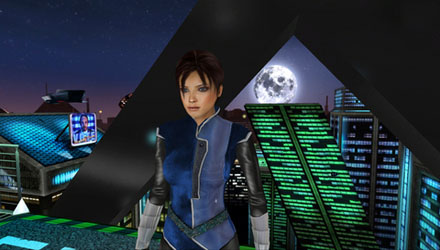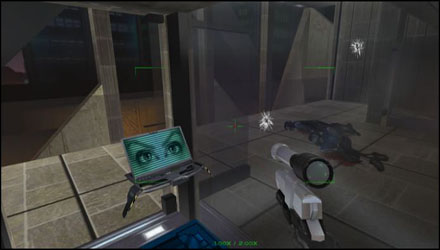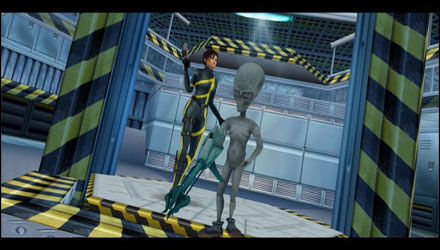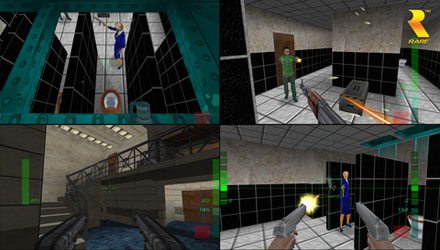Reviews
Review: Perfect Dark XBLA
June 24, 2010, Author: James Sheppard
These days, game releases from Rare are often niche titles that don’t always meet brilliant critical reception. Back in the day of the Nintendo 64 however, they were well known for their awesome exclusives; Banjo Kazooie, Goldeneye, Conker’s Bad Fur Day and Donkey Kong 64 being some notable examples. Perfect Dark was released in 2000, near the end of the Nintendo 64’s lifetime and had the typical Rare quality that made it one hell of an astonishing game. It pushed the Nintendo 64 to its absolute limit, being one of the only titles that required the Expansion Pak to handle its demanding needs; and it still ran god-awful at times regardless.
Now ten years later, Perfect Dark has been remade for release on the Xbox Live Arcade, at the price of 800 Microsoft Points. Being a remake of a ten year old game, it is obviously one primarily for fans of the original, but I’m still going to lift off the nostalgia-glasses for this review and see how much fun a new player could get out of it. Can we still appreciate it as a classic today, or does Perfect Dark now seem a bit too flawed?
Perfect premise?
For the benefit of you newcomers: It’s 2023, and as Agent Joanna Dark (nicknamed Perfect Dark for her exceptional abilities) you are hired by the Carrington Institute to kick some futuristic butt, in the form of the malevolent DataDyne corporation, and later the alien Skedars. I’ll try not to spoil too much for those newbies, and those veterans with a rubbish memory who’ll have forgotten the storyline by now, like I had. The game starts with Joanna being flown to the DataDyne headquarters, to infiltrate the building and recover an insider called Dr. Carroll. This ‘doctor’ in fact turns out to be a hovering laptop with big googly eyes and a rather charming, artificially intelligent, personality. Conspiracies unravel, and throughout a fairly varied selection of levels, Joanna saves the world and ultimately the universe.
Overall, Perfect Dark has an intriguing sci-fi storyline, albeit a bit bizarre. It was admittedly more interesting ten years ago, when original storylines such as this with twists and turns were less common in videogames, especially in first person shooters. Unarguably today though, there is still more than enough to keep you hooked on the single player mode to reach its conclusion.

Joanna Dark... erm... in the Dark...
Perfect play?
In 2000, Perfect Dark’s gameplay made it a literally ground breaking N64 shooter, with only its unofficial predecessor Goldeneye coming close to its enormous arsenal of weapons and gadgets, brilliant level design, and impressive enemy intelligence. Furthermore, the level of content is huge, with a large single-player story mode, each difficulty level increasing the challenge and amount of objectives.
There is also the cooperative mode, Counter-Operative where one player controls the level’s enemies, a Combat Simulator with an array of challenges and a stunning multiplayer mode and to top it all off, a great hub in the form of the Carrington Institute to access this all from and spend some time in. I want to begin by talking about this. I feel they don’t make game hubs like they used to. How about Mario 64’s castle to explore inbetween missions or Sunshine’s town to jetpack around in? Mario Galaxy’s hub paled in comparison, with little more than doors leading you to the levels, and a lame room where Peach would tell you fairy tales. Boooo-ring. I barely know of any first-person shooters nowadays that have a hub, either.
Perfect Dark’s hub, however, is fantastic, with training missions and an addictive firing range to hone your skills and beat your high scores. Even better, by shifting a crate from downstairs and using it to wedge the door open, you can wreak havoc around the Institute by sneaking out any weapon you please and blowing stuff up/throwing knives in unwitting friendlies heads. Brilliant!

Oh crap, what the hell's up with my TV?
Onto the proper meat of the game though, for you more serious types. The levels are often very short by today’s standards, but this isn’t an issue, as there are quite a lot of them, and they just feel like more of a quick blast of arcade fun as a result. There are also quite a variety of levels, such as futuristic urban locations, laboratories, an aeroplane and an alien headquarters. On offer are many more objectives than simply ‘Kill anything that moves,’ as well, often requiring the use of gadgets such as your remotely controllable Camspy to spy on meetings (ultimate pervert tool of the future), and gadgets to hack computer terminals, safe doors and even futuristic hover-taxis.
These objectives increase in number with the difficulty setting, something that makes a huge difference in Perfect Dark. ‘Agent’ difficulty, i.e. ‘Easy,’ is insultingly simple at times, at least as far as the enemies go. It’s like fighting drugged up pensioners trying to shoot you with BB pellet guns, using their heavily arthritic hands. In contrast however, ‘Perfect Agent’ mode can be downright cruel. ‘Special Agent’ is a happy medium, but unfortunately you are first forced to play through the game in the easiest mode before it is unlocked. Seriously, you can stand right in front of the ‘Agent’ guards sometimes and dance around completely unscathed, making you wonder how they ever got employed in the first place.
The mission objectives at least can still offer some challenge, with the lack of modern aids we take for granted, such as objective markers and directional arrows. Because of this, expect to spend plenty of time actually paying attention during cutscenes, (fancy that?) reading menus in detail to determine exactly what you’re meant to do, and most of all, fumbling around the level like a blind man trying to find a potato growing on an apple tree. I’m not sure whether this reflects badly on the game itself, or on us lazy gamers who are used to being led round games by the hand nowadays.
It’s bad enough trying to find the way on your own, but when accompanied by a friendly AI character the problem is increased tenfold. Seriously, I found the evacuation of Dr. Carroll a nightmare; he is perhaps the dumbest flying laptop I have seen in my life (must be a Dell from the future). Trying to herd him through the network of corridors and elevators throughout the level requires the patience of a saint, highlighting the severely outdated AI that has remained intact in the port. I have to say, some aspects of the game were probably ahead of its time, but more than anything it’s the artificial intelligence (or lack of it) that keeps reminding me this is in fact a game from ten years ago.

Even Ctrl+Alt+Del can't sort this idiot out.
There are still many a moment of gaming gold that shine through, however. One addictive mode is the thirty challenges on offer in the Combat Simulator, something that may initially go unnoticed but presents some interesting scenarios. Similarly to the campaign, they are initially easier than playing chess against your pet dog, but by the end you will be cursing the day you ever spent those 800 Microsoft Points. Mercifully, the game will give you an Achievement for finishing 29 not 30 of the levels, as the last is practically impossible.
The range of weapons in the game is incredible, with thirty-two shooters to get your mitts on, all with secondary fire abilities. There are some real ingenious inclusions that are impressive by today’s standards, let alone of those ten year ago. How do player-guided rocket launchers sound? The infamous Laptop gun that can be mounted on walls as a sentry gun? SMG’s with lock-on? The Dragon, an assault rifle that can be chucked on the floor as bait, with a sneaky proximity mine function? There are so many varied weapons to utilise and master that combat never gets boring.
The shooting controls are also much improved. As much as I loved my Nintendo 64, I never did quite ‘get’ the controller. It was about as ergonomic as using the base of a pitchfork thanks to its daft three-pronged design, and required the hands of a large ape if you actually wanted to use it in comfort. In contrast then, the Xbox 360 pad is heaven and practically makes it worth upgrading just for this. You also have the choice of the classic controller layout for purists, or for newcomers, the cheekily named ‘Spartan’ and ‘Duty Calls’ configurations for Halo and Call of Duty fans respectively.

Office work of the future: drawing green lines
Perfect presentation?
The graphics may have been impressive in the year 2000, although predictably now they are looking very aged, particularly the character models which are quite chunky and all have club hands, in a permanent state of closed fists (maybe they’re angry at how unrealistic they look). Rare have made a decent effort though, and hugely upgraded the game’s resolution, and quality of the textures. As basic as the graphics are, they are rarely ugly because they are at least very clear and crisp. Comparing it to the N64 original side by side, it still is completely recognisable but just a lot less fuzzy, something that is very welcome. Even better, despite the use of the Expansion Pack, the N64 version still had an appalling frame-rate when things got hectic, and this of course is no longer an issue (as you’d hope from a machine with far more grunt). To an extent then, it could be said that this Xbox 360 remake is how the original should have looked and performed, in an ideal world.
Perfect pitch?
It’s hard to rate the sound effects. On one hand, the soundtrack consists of plinky-plonky MIDI style tracks, and sound effects include pea-shooter weapon noises and unbelievably dire voice acting (enemies hysterically scream “AARRGHH,” and “WHY ME?!” when you kill them). On the other hand, Perfect Dark is a blast from the past and updating the sound would have lost a certain something (not to mention the music may be basic but it’s still surprisingly catchy). It would be like making a port of Atari games and updating them with a fully orchestrated musical score; it’d be nice and all, but something would be a bit off. You’ll never be tempted to reach for the mute button anyway, and the amount of music in the game is quite impressive, with a BGM for basically every single menu and level, helping create the general ambient mood of the environments.

Joanna's buddy, Elvis. Using him is akin to playing the Monkey character in Timesplitters (i.e. CHEATING)
Perfect party?
Perfect Dark was famous for its multiplayer abilities when it was released, and understandably so. A fully co-operative campaign, the counter-operative campaign and a deathmatch mode absolutely crammed to the brim with maps, weapons and features. Eight bots in a range of difficulties? Revolutionary! Okay, maybe not so much today. Surprisingly, and perhaps disappointingly, it’s probably the multiplayer mode that I feel is now the most old-fashioned thanks to the enormous advancements that have been made in gameplay (damn you, improvement!).
Online is now an option, which is of course a very modern addition, but the games are between a maximum of either four or eight players (of which you’ll struggle to find anyway), and what ruins the deal for me is the terrible connection, at least that I have experienced. The lag makes online multiplayer not really worth bothering with in my opinion, but arguably you’re best all crowding round the same TV with your mates anyway (wow, we actually used to do that back in the day, didn’t we?)
There is still some fun to be had, despite the lack of unlocks, perks, killstreak bonuses and any other new-fangled features we get in first person shooters these days. Which reminds me, Call of Duty: Modern Warfare 2 may have received some flack for its cheap tactics, but compared to Perfect Dark it has little to worry about. Take the Farsight, which sees enemies through walls and locks on at the push of the aim button, or the powerful aforementioned Laptop gun sentry. Not to mention proximity mines, easily hidden underneath an ammo crate. If this game was more mainstream online, Xbox Live kiddies would be screaming cuss words and racist slurs before you could say, “Oh darn you, you unsporting fellow.”

Perfect Dark: Toilet Warfare
Perfect marks?
I feel that Rare’s conversion of this classic has been a success. There are definite cracks showing from seemingly ancient AI, visuals and sometimes simplistic gameplay, but Perfect Dark still has a lot of fun to offer. The original atmosphere of the game is still there, as engrossing as ever. I enjoyed the main story mode more than I thought I would, as it’s definitely back to basics, but there’s an enjoyable simplicity about it all. The game no longer feels like a big blockbuster when compared to modern titles, but more of a fun-packed arcade game, perfectly suited to the ‘Xbox Live Arcade’. Unlike most games, I also felt inclined to beat my scores for the firing range and mission completion time also. Multiplayer online is flawed, but local play is still present, something still good but perhaps most enjoyable for fans of the original.
Overall what definitely must not be understated, is that the depth of content in Perfect Dark is massive, even by the standards of a new full-release game. As an Xbox Live Arcade game though? It’s superbly good value, especially at the very reasonable price of 800 Microsoft Points. 1200 Points for… a few maps… *ahem*… or 800 Points for a complete package like Perfect Dark is a no-brainer. Go ahead and buy it, whether you’re a long time fan or a total newcomer, and I doubt you’ll regret it.
Platforms: Xbox 360 | Tagged FPS, Joanna, Microsoft, N64, Nintendo 64, Perfect Dark, Remake, Shooter, XBLA, Xbox 360, Xbox Live Arcade



